
Welcome to Hyperion Records, a British classical label devoted to presenting high-quality recordings of music of all styles and from all periods from the twelfth century to the twenty-first.
Hyperion offers both CDs, and downloads in a number of formats. The site is also available in several languages.
Please use the dropdown buttons to set your preferred options, or use the checkbox to accept the defaults.

The Mass is scored for five voices, within which Taverner makes effective use of contrasting high and low groups. Simple and clear textures, and extensive use of imitation, combine to create a decidedly more ‘modern’ music than is found in his large-scale and elaborate six-voice masses. The ‘long’ movements, the Gloria and Credo, are set in a functional, predominantly syllabic style, while the Sanctus-Benedictus and Agnus Dei are given melismatic treatment, so that the four movements are balanced in length and weight. Overtly expressive writing is limited to the conventional pauses at ‘Jesu’ and ‘Et homo factus est’, but Taverner achieves a marvellous sense of climax through his favourite device of melodic sequence in the Osanna of the Sanctus.
from notes by John Heighway © 2000
La Messe est orchestrée pour cinq voix, et dans ce contexte Taverner utilise avec beaucoup d’effet le contraste de groupes supérieurs et inférieurs. Des textures simples et claires, et l’utilisation importante de l’imitation, s’unissent pour créer une musique décidément plus «moderne» que celle que nous trouvons dans ses Messes à six voix, qui sont des ouvrages complexes et composés sur une plus grande échelle. Les mouvements «longs», le Gloria et le Credo sont arrangés dans un style fonctionnel, de manière prédominante syllabique, tandis que le Sanctus-Benedictus et l’Agnus Dei reçoivent un traitement mélismatique, ce qui donne aux quatre mouvements un équilibre de longueur et de force. Une écriture ouvertement expressive se limite aux pauses conventionnelles à «Jesu» et «Et homo factus est», mais Taverner réussit à traduire un merveilleux sentiment de culmination grâce à sa formule préférée de séquence mélodique dans l’Osanna du Sanctus.
extrait des notes rédigées par John Heighway © 2000
Français: Hypérion
Die Messe ist fünfstimmig angelegt, und in diesem Rahmen nutzt Taverner geschickt kontrastierende hohe und tiefe Gruppierungen aus. Einfache, klare Strukturen und reichlich Imitation tragen dazu bei, eine entschieden „modernere“ Musik zu schaffen, als sie in seinen umfangreicheren und kunstvolleren sechsstimmigen Messen zu finden ist. Die „langen“ Sätze Gloria und Credo sind in funktionellem, hauptsächlich syllabischem Stil gehalten, während Sanctus-Benedictus und Agnus Dei melismatisch behandelt werden, so dass die vier Sätze in Bezug auf Länge und Gewicht ausgeglichen sind. Offenkundig, expressive Komposition ist beschränkt auf die konventionellen Pausen bei „Jesu“ und „Et homo factus est“, doch erzeugt Taverner mit seinem bevorzugten Stilmittel der melodischen Sequenz beim Osanna des Sanctus auf wundersame Weise das Gefühl, einen Höhepunkt zu erleben.
aus dem Begleittext von John Heighway © 2000
Deutsch: Anne Steeb/Bernd Müller
 The Sixteen & The Golden Age of English Polyphony The Sixteen & The Golden Age of English PolyphonyWhen The Sixteen embarked upon their recording career back in 1982, few would have been able to predict quite how far they would go towards rehabilitating the little-known music of these four master composers of the 16th century. In this their 30t ...» More |

